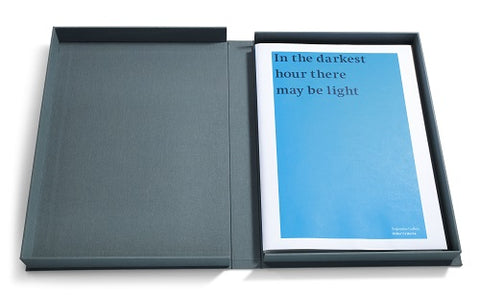The exhibition is considered one of Hirst's most influential to date. Curated by the artist himself, the critically-acclaimed show brought together the works of Hirst’s friends and contemporaries, from Francis Bacon to Sarah Lucas and Andy Warhol to Gavin Turk.
The exhibition included paintings, sculptures, photographs and installations that situated Hirst's own practice within an ongoing tradition of radical postmodernism and unflinching existential contemplation.
The Box Set
To coincide with Hirst's show, The Serpentine Gallery and Other Criteria co-published a print portfolio of 23 limited edition art prints, created especially for the occasion by the artists involved. Each print in the box set is from a signed limited edition of 50.
The roster of artists featured in the box set includes Banksy, Don Brown, Angela Bulloch, John Currin, Tracey Emin, Angus Fairhurst, Steven Gregory, Marcus Harvey, Rachel Howard, John Isaacs, Michael Joo, Jeff Koons, Jim Lambie, Sean Landers, Tim Lewis, Sarah Lucas, Nicholas Lumb, Tom Ormond, Laurence Owen, Richard Prince, Haim Steinbach, Gavin Turk and, of course, Damien Hirst.
Box Set Highlights
Sarah Lucas
Part of the generation of Young British Artists, Sarah Lucas rose to prominence in the 1990s. Her work is known for its sexually provocative content, treading the fine line between bawdy humour and unsettling provocation.
Straddling sculpture, collage, photography and objet d’art, Lucas’ work is ceaselessly pioneering and enduringly relevant, speaking as lucidly to today’s audiences as it did to its initial viewers over three decades ago.

Photo: © Maureen M Evans
Angela Bulloch
Another YBA, Angela Bulloch is known for her light and sound installations which explore the mechanics of pre-digital systems. Nominated for the Turner Prize in 1997, Bullock has exhibited at galleries across the world, including, The Museum of Contemporary Art in Chicago, The Hayward Gallery, Tate Liverpool, and the Guggenheim.
Bulloch works across medias, incorporating video, installation, sculpture and painting into her practice for a varied and consistently wide-ranging aesthetic.
 Angela Bulloch © Andrea Rossetti
Angela Bulloch © Andrea Rossetti
Angus Fairhurst
The late Angus Fairhurst (another of the YBAs) graduated in Fine Art at Goldsmith’s college in 1989, where he studied alongside Damien Hirst. With Hirst, Fairhurst was instrumental in the organisation of ‘Freeze’, the exhibition that would launch the careers of the Young British Artists.
Like his some-time collaborator, Sarah Lucas, Fairhurst’s work is characterised by a penchant for visual distortion and tomfoolery, upsetting the familiar to introduce the uncanny and tipping from the comical to the unnerving with easy confidence.
Working across a variety of media, including video, photography and painting, Fairhurst is best known for his gorilla sculptures, which depict the primates in various states of existential confrontation.

Laurence Owen
Laurence Owen is contemporary British artist, known for paintings and ceramics that explore the lasting value of Folklore, Paganism and early Mythology in contemporary culture.
Through his work, Owen has developed a language reminiscent of artefact and relic, placing him in a tradition of contemporary ceramicists, alongside the likes of Grayson Perry and Elisabeth Kley.
In the production of these art objects, Owen looks at themes of ritual and worship, and asks the extent to which these systems still hold sway in consumerist cultures. His aesthetic is characterised by their use of bright colour and bold composition, and the fluid merging of the abstract with the figurative.

Don Brown
Contemporary British artist Don Brown is known for his figurative sculptural works, usually depicting his wife Yoko in various states of undress. Harking back to the muse of classical sculpture, Brown modernises the antiquated form by eschewing idealisation: these are intimate and sensuous renderings of Yoko, often produced at three-quarter or half-scale, in a variety of smooth surfaces, from bronze to acrylic.
Celebrated for their technical skill, Brown’s works are exemplars of verisimilitude, capturing the subject with a vivid sense of presence. Other recent projects have included oversized sculptural still life and pastel drawings.

Copyright: © 2004 Dennis Schoenberg
Michael Joo
Science graduate turned artist Michael Joo blurs the boundaries between art and science through his investigations into ontology and epistemology, opening interdisciplinary and multi-sensory channels which probe the realities of perception.
Blending sculpture, painting, photography and print-making, Joo’s work generates narratives that explore interactions between places, people and objects with profound effect.

The Exhibition
Hirst’s exhibition (and the accompanying print collection) takes its title from the Hans Christian Anderson fairytale, ‘The Galoshes of Fortune’ (1838). Typically morbid, Hirst chose the line to reflect the idea of 'just amassing stuff while you’re alive.'
If this is a comment on the darker side of material culture and the marketisation of the art world, Hirst’s choice of title also contains seeds of hope. ‘In the darkest hour there may be light’ rings like a clarion call for people to make politicised art that confronts the ecological and economic impact of materialism.
A selection of artworks from this rare box set will be on display at our 2024 Rare Print Show. Find out more and RSVP here.






